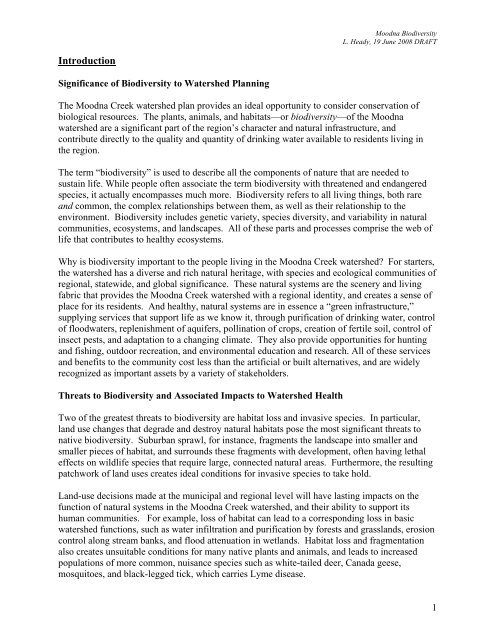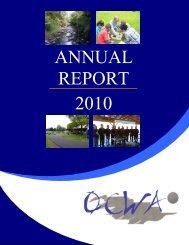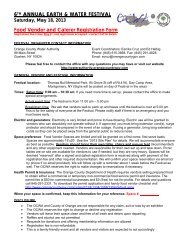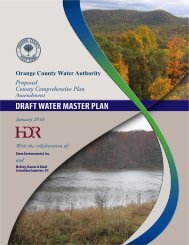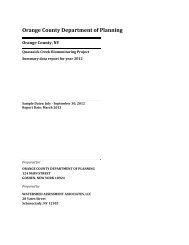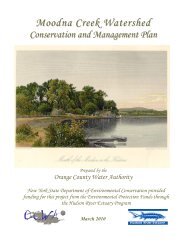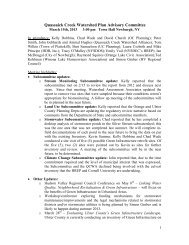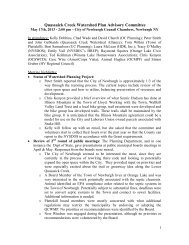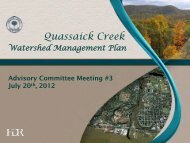Biodiversity of the Moodna Creek Watershed - Orange County Water ...
Biodiversity of the Moodna Creek Watershed - Orange County Water ...
Biodiversity of the Moodna Creek Watershed - Orange County Water ...
You also want an ePaper? Increase the reach of your titles
YUMPU automatically turns print PDFs into web optimized ePapers that Google loves.
<strong>Moodna</strong> <strong>Biodiversity</strong><br />
L. Heady, 19 June 2008 DRAFT<br />
Introduction<br />
Significance <strong>of</strong> <strong>Biodiversity</strong> to <strong><strong>Water</strong>shed</strong> Planning<br />
The <strong>Moodna</strong> <strong>Creek</strong> watershed plan provides an ideal opportunity to consider conservation <strong>of</strong><br />
biological resources. The plants, animals, and habitats—or biodiversity—<strong>of</strong> <strong>the</strong> <strong>Moodna</strong><br />
watershed are a significant part <strong>of</strong> <strong>the</strong> region’s character and natural infrastructure, and<br />
contribute directly to <strong>the</strong> quality and quantity <strong>of</strong> drinking water available to residents living in<br />
<strong>the</strong> region.<br />
The term “biodiversity” is used to describe all <strong>the</strong> components <strong>of</strong> nature that are needed to<br />
sustain life. While people <strong>of</strong>ten associate <strong>the</strong> term biodiversity with threatened and endangered<br />
species, it actually encompasses much more. <strong>Biodiversity</strong> refers to all living things, both rare<br />
and common, <strong>the</strong> complex relationships between <strong>the</strong>m, as well as <strong>the</strong>ir relationship to <strong>the</strong><br />
environment. <strong>Biodiversity</strong> includes genetic variety, species diversity, and variability in natural<br />
communities, ecosystems, and landscapes. All <strong>of</strong> <strong>the</strong>se parts and processes comprise <strong>the</strong> web <strong>of</strong><br />
life that contributes to healthy ecosystems.<br />
Why is biodiversity important to <strong>the</strong> people living in <strong>the</strong> <strong>Moodna</strong> <strong>Creek</strong> watershed? For starters,<br />
<strong>the</strong> watershed has a diverse and rich natural heritage, with species and ecological communities <strong>of</strong><br />
regional, statewide, and global significance. These natural systems are <strong>the</strong> scenery and living<br />
fabric that provides <strong>the</strong> <strong>Moodna</strong> <strong>Creek</strong> watershed with a regional identity, and creates a sense <strong>of</strong><br />
place for its residents. And healthy, natural systems are in essence a “green infrastructure,”<br />
supplying services that support life as we know it, through purification <strong>of</strong> drinking water, control<br />
<strong>of</strong> floodwaters, replenishment <strong>of</strong> aquifers, pollination <strong>of</strong> crops, creation <strong>of</strong> fertile soil, control <strong>of</strong><br />
insect pests, and adaptation to a changing climate. They also provide opportunities for hunting<br />
and fishing, outdoor recreation, and environmental education and research. All <strong>of</strong> <strong>the</strong>se services<br />
and benefits to <strong>the</strong> community cost less than <strong>the</strong> artificial or built alternatives, and are widely<br />
recognized as important assets by a variety <strong>of</strong> stakeholders.<br />
Threats to <strong>Biodiversity</strong> and Associated Impacts to <strong><strong>Water</strong>shed</strong> Health<br />
Two <strong>of</strong> <strong>the</strong> greatest threats to biodiversity are habitat loss and invasive species. In particular,<br />
land use changes that degrade and destroy natural habitats pose <strong>the</strong> most significant threats to<br />
native biodiversity. Suburban sprawl, for instance, fragments <strong>the</strong> landscape into smaller and<br />
smaller pieces <strong>of</strong> habitat, and surrounds <strong>the</strong>se fragments with development, <strong>of</strong>ten having lethal<br />
effects on wildlife species that require large, connected natural areas. Fur<strong>the</strong>rmore, <strong>the</strong> resulting<br />
patchwork <strong>of</strong> land uses creates ideal conditions for invasive species to take hold.<br />
Land-use decisions made at <strong>the</strong> municipal and regional level will have lasting impacts on <strong>the</strong><br />
function <strong>of</strong> natural systems in <strong>the</strong> <strong>Moodna</strong> <strong>Creek</strong> watershed, and <strong>the</strong>ir ability to support its<br />
human communities. For example, loss <strong>of</strong> habitat can lead to a corresponding loss in basic<br />
watershed functions, such as water infiltration and purification by forests and grasslands, erosion<br />
control along stream banks, and flood attenuation in wetlands. Habitat loss and fragmentation<br />
also creates unsuitable conditions for many native plants and animals, and leads to increased<br />
populations <strong>of</strong> more common, nuisance species such as white-tailed deer, Canada geese,<br />
mosquitoes, and black-legged tick, which carries Lyme disease.<br />
1


